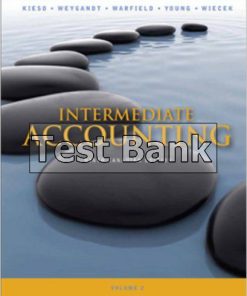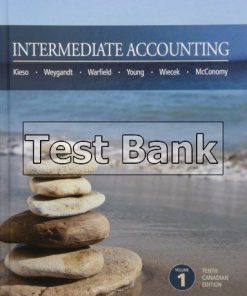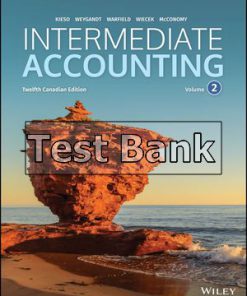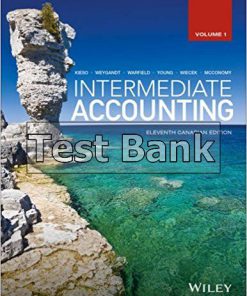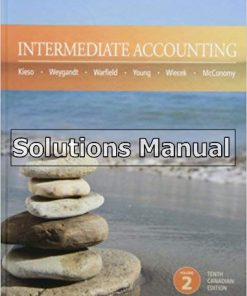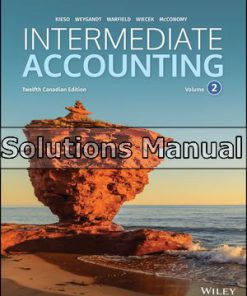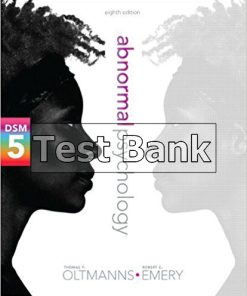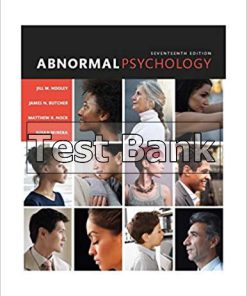Intermediate Accounting Volume 2 Canadian 11th Edition Kieso Test Bank
$26.50$50.00 (-47%)
Intermediate Accounting Volume 2 Canadian 11th Edition Kieso Test Bank.
You may also like
Intermediate Accounting Volume 2 Canadian 11th Edition Kieso Test Bank
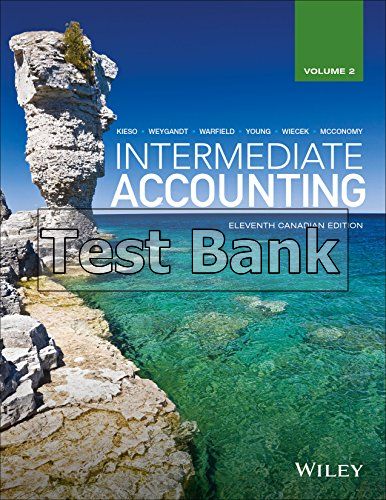
Product details:
- ISBN-10 : 1119274427
- ISBN-13 : 978-1119274421
- Author: Kieso, Weygandt, Warfield, Young, Wiecek
The Kieso, Weygandt, Warfield, Young, Wiecek, McConomy: Intermediate Accounting text has an outstanding reputation as “THE” text for intermediate accounting and is viewed as a reliable resource by accounting students, faculty, and professionals. After listening carefully to instructors and students alike, and after having built on what we have learned over ten successful editions and more than 30 years of being the market leader, we are confident that the eleventh edition will continue to meet the needs of instructors and students.
Table contents:
- CHAPTER 13 Non-Financial and Current Liabilities
- UNDERSTANDING NON-FINANCIAL AND CURRENT LIABILITIES
- RECOGNITION AND MEASUREMENT
- Liability Definition and Characteristics
- Financial Liabilities and Non-Financial Liabilities
- Measurement
- COMMON CURRENT LIABILITIES
- What Is a Current Liability?
- Bank Indebtedness and Credit Facilities
- Accounts Payable
- Notes Payable
- Current Maturities of Long-Term Debt
- Short-Term Debt Expected to Be Refinanced
- Dividends Payable
- Rents and Royalties Payable
- Customer Advances and Deposits
- Taxes Payable
- EMPLOYEE-RELATED LIABILITIES
- Payroll Deductions
- Short-Term Compensated Absences
- Profit-Sharing and Bonus Agreements
- NON-FINANCIAL LIABILITIES
- Decommissioning and Restoration Obligations
- Unearned Revenues
- Product Guarantees and Customer Programs
- Contingencies, Uncertain Commitments, and Requirements for Guarantees and Other Commitments
- PRESENTATION, DISCLOSURE, AND ANALYSIS
- Presentation and Disclosure of Current Liabilities
- Presentation and Disclosure of Contingencies, Guarantees, and Commitments
- Analysis
- IFRS/ASPE COMPARISON
- A Comparison of IFRS and ASPE
- Looking Ahead
- CHAPTER 14 Long-Term Financial Liabilities
- UNDERSTANDING DEBT INSTRUMENTS
- Bonds and Notes Payable
- Credit Ratings
- Defeasance
- Types of Companies that Have Significant Debt Financing
- Information for Decision-Making
- MEASUREMENT
- Bonds and Notes Issued at Par
- Discounts and Premiums
- Special Situations
- RECOGNITION AND DERECOGNITION
- Repayment before Maturity Date
- Exchange of Debt Instruments
- Troubled Debt Restructurings
- Defeasance Revisited
- Off–Balance Sheet Financing
- PRESENTATION, DISCLOSURE, AND ANALYSIS
- Presentation
- Disclosures
- Analysis
- IFRS/ASPE COMPARISON
- A Comparison of IFRS and ASPE
- Looking Ahead
- CHAPTER 15 Shareholders’ Equity
- UNDERSTANDING THE CORPORATE FORM, SHARE CAPITAL, AND PROFIT DISTRIBUTION
- Corporate Law and the Share Capital System
- Types of Shares
- Limited Liability of Shareholders
- Formality of Profit Distribution
- RECOGNITION, DERECOGNITION, AND MEASUREMENT
- Issuance of Shares
- Reacquisition, Retirement, and Conversion of Shares
- Dividends
- PRESENTATION, DISCLOSURE, AND ANALYSIS
- Components of Shareholders’ Equity
- Capital Disclosures
- Analysis
- IFRS/ASPE COMPARISON
- A Comparison of IFRS and ASPE
- Looking Ahead
- APPENDIX 15A—PAR VALUE AND TREASURY SHARES
- Par Value Shares
- Treasury Shares
- APPENDIX 15B—FINANCIAL REORGANIZATION
- Comprehensive Revaluation
- CHAPTER 16 Complex Financial Instruments
- DERIVATIVES
- Managing Risks
- Accounting for Derivatives
- DEBT VERSUS EQUITY: ISSUER PERSPECTIVE
- Economics of Complex Financial Instruments
- Presentation and Measurement of Hybrid/Compound Instruments
- SHARE-BASED COMPENSATION
- Types of Plans
- Recognition, Measurement, and Disclosure of Share-Based Compensation
- IFRS/ASPE COMPARISON
- A Comparison of IFRS and ASPE
- Looking Ahead
- APPENDIX 16A—HEDGING
- Derivatives Used for Hedging and the Need for Hedge Accounting Standards
- Hedge Accounting
- APPENDIX 16B—STOCK COMPENSATION PLANS— ADDITIONAL COMPLICATIONS
- Share Appreciation Rights Plans
- Performance-Type Plans
- APPENDIX 16C—ADVANCED MODELS FOR MEASURING FAIR VALUE AND DISCLOSURE OF FAIR VALUE INFORMATION
- Options Pricing Models
- Fair Value Disclosure for Financial Instruments
- CHAPTER 17 Earnings per Share
- OVERVIEW
- Objective of EPS
- Presentation and Disclosure
- BASIC EPS
- Capital Structure
- Income Available to Common/Ordinary Shareholders
- Weighted Average Common/Ordinary Shares
- Comprehensive Illustration
- DILUTED EPS
- Complex Capital Structure
- Convertible Securities
- Options and Warrants
- Contingently Issuable Shares
- Antidilution Revisited
- Additional Disclosures
- Comprehensive Earnings per Share Exercise
- ANALYSIS AND IFRS/ASPE COMPARISON
- Analysis
- A Comparison of IFRS and ASPE and Looking Ahead
- CHAPTER 18 Income Taxes
- INCOME TAXES FROM A BUSINESS PERSPECTIVE
- CURRENT INCOME TAXES
- Accounting Income and Taxable Income
- Calculation of Taxable Income
- Calculation of Current Income Taxes
- DEFERRED/FUTURE INCOME TAXES
- Deferred Tax Liabilities
- Deferred Tax Assets
- Income Tax Accounting Objectives and Analyses of Temporary Deductible Differences
- Tax Rate Considerations
- INCOME TAX LOSS CARRYOVER BENEFITS
- Loss Carryback Illustrated
- Loss Carryforward Illustrated
- Review of Deferred Tax Asset Account
- PRESENTATION, DISCLOSURE, AND ANALYSIS
- Statement of Financial Position Presentation
- Income and Other Statement Presentation
- Disclosure Requirements
- Analysis
- Outstanding Conceptual Questions
- IFRS/ASPE COMPARISON
- A Comparison of IFRS and ASPE
- Looking Ahead
- APPENDIX 18A—COMPREHENSIVE ILLUSTRATION
- First Year of Operations—2017
- Second Year of Operations—2018
- CHAPTER 19 Pensions and Other Post-Employment Benefits
- INTRODUCTION AND BENEFIT PLAN BASICS
- Overview of Pensions and Their Importance from a Business Perspective
- Defined Contribution Plans
- Defined Benefit Plans
- DEFINED BENEFIT PENSION PLANS
- The Employer’s Obligation
- Plan Assets
- Surplus or Deficit
- Defined Benefit Cost Components
- Other Defined Benefit Plans
- PRESENTATION, DISCLOSURE, AND ANALYSIS
- Presentation
- Disclosure
- Analysis
- IFRS/ASPE COMPARISON
- A Comparison of IFRS and ASPE
- Looking Ahead
- APPENDIX 19A—EXAMPLE OF A ONE-PERSON PLAN
- Current Service Cost
- Defined Benefit Obligation
- Past Service Cost
- CHAPTER 20 Leases
- LEASING BASICS
- Importance of Leases from a Business Perspective
- The Leasing Environment
- IFRS AND ASPE APPROACH—LESSEES
- Lease Criteria
- Determination of Rental Payments
- Accounting for a Right-of-Use Asset
- Accounting for Residual Values and Purchase Options in a Finance Lease
- Accounting for an Operating Lease
- Capital and Operating Leases Compared under ASPE
- Presentation and Disclosure
- IFRS AND ASPE APPROACH—LESSORS
- Classification Criteria
- Accounting for Financing and Manufacturer/Dealer or Sales-Type Leases
- Accounting for Residual Values and Purchase Options in a Financing or Manufacturer/Dealer or Sales-T
- Accounting for an Operating Lease
- IFRS/ASPE COMPARISON
- A Comparison of IFRS and ASPE
- Looking Ahead
- APPENDIX 20A—OTHER LEASE ISSUES
- Sale and Leaseback Transactions
- Real Estate Leases
- APPENDIX 20B—LESSEE ACCOUNTING UNDER IAS 17
- IFRS Criteria
- CHAPTER 21 Accounting Changes and Error Analysis
- CHANGES IN ACCOUNTING POLICIES AND ESTIMATES, AND ERRORS
- Types of Accounting Changes
- Alternative Accounting Methods
- Accounting Standards
- Retrospective Application—Change in Accounting Policy
- Retrospective Restatement—Correction of an Error
- Prospective Application
- ANALYSIS
- Motivations for Change
- Interpreting Accounting Changes
- IFRS/ASPE COMPARISON
- A Comparison of IFRS and ASPE
- Looking Ahead
- APPENDIX 21A—ERROR ANALYSIS
- Statement of Financial Position Errors
- Income Statement Errors
- Statement of Financial Position and Income Statement Errors
- Comprehensive Illustration: Numerous Errors
- Preparation of Comparative Financial Statements
- CHAPTER 22 Statement of Cash Flows
- INTRODUCTION TO CASH FLOWS AND THE STATEMENT OF CASH FLOWS
- Purpose, Uses, and Importance from a Business Perspective
- What Is Included in Cash?
- Classification of Cash Flows
- Format of the Statement
- PREPARING A STATEMENT OF CASH FLOWS
- Illustration Using the Direct Method— Tax Consultants Inc.
- Illustration Using the Indirect Method—Eastern Window Products Limited
- Illustration Using Both Methods—Yoshi Corporation
- PRESENTATION
- Disclosure Requirements
- Presentation Requirements
- Illustrative Example
- ANALYZING THE STATEMENT OF CASH FLOWS
- Interpreting the Statement of Cash Flows
- Sensitivity Analysis
- Free Cash Flow
- IFRS/ASPE COMPARISON
- A Comparison of IFRS and ASPE
- Looking Ahead
- APPENDIX 22A— USE OF A WORK SHEET
- Preparing the Work Sheet
- Analyzing Transactions
- Completing the Work Sheet
- CHAPTER 23 Other Measurement and Disclosure Issues
- DISCLOSURE ISSUES
- The Importance of Disclosure from a Business Perspective
- Full Disclosure Principle
- Accounting Policies
- Segmented Reporting
- Interim Reporting
- OTHER MEASUREMENT ISSUES
- Related-Party Transactions
- Subsequent Events
- Bankruptcy and Receivership
- AUDITOR’S REPORTS
- Unmodified Opinions
- Qualified Opinions and Disclaimers of Opinion
- Adverse Opinions
- FINANCIAL STATEMENT ANALYSIS
- An Overview of Financial Statement Analysis
- Financial Statement Analysis Techniques
- Limitations of Financial Statement Analysis
- IFRS/ASPE COMPARISON
- A Comparison of IFRS and ASPE
- Looking Ahead
- APPENDIX: SPECIMEN FINANCIAL STATEMENTS
- Brookfield Asset Management
- TABLES
- GLOSSARY
- COMPANY INDEX
- SUBJECT INDEX
- EULA
People also search:
intermediate accounting 2 chapter 11
intermediate accounting 2 chapter 10
intermediate accounting volume 2 12th canadian edition
intermediate accounting 12th edition
intermediate accounting 11th edition

